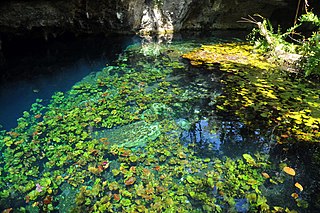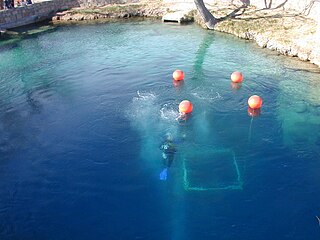Related Research Articles

Cave diving is underwater diving in water-filled caves. It may be done as an extreme sport, a way of exploring flooded caves for scientific investigation, or for the search for and recovery of divers lost as a result of one of these activities. The equipment used varies depending on the circumstances, and ranges from breath hold to surface supplied, but almost all cave diving is done using scuba equipment, often in specialised configurations with redundancies such as sidemount or backmounted twinset. Recreational cave diving is generally considered to be a type of technical diving due to the lack of a free surface during large parts of the dive, and often involves planned decompression stops. A distinction is made by recreational diver training agencies between cave diving and cavern diving, where cavern diving is deemed to be diving in those parts of a cave where the exit to open water can be seen by natural light. An arbitrary distance limit to the open water surface may also be specified.

The Cave Diving Group (CDG) is a United Kingdom-based diver training organisation specialising in cave diving.
The Woodville Karst Plain Project or WKPP, is a project and organization that maps the underwater cave systems underlying the Woodville Karst Plain. This plain is a 450-square-mile (1,200 km2) area that runs from Tallahassee, Florida, U.S. to the Gulf of Mexico and includes numerous first magnitude springs, including Wakulla Springs, and the Leon Sinks Cave System, the longest underwater cave in the United States. The project grew out of a cave diving research and exploration group established in 1985 and incorporated in 1990.

Ankarana Special Reserve in northern Madagascar was created in 1956. It is a small, partially vegetated plateau composed of 150-million-year-old middle Jurassic limestone. With an average annual rainfall of about 2,000 millimetres (79 in), the underlying rocks have been eroded to produce caves and feed subterranean rivers—a karst topography. The rugged relief and the dense vegetation have helped protect the region from human intrusion.

Cocklebiddy is a small roadhouse community located on the Eyre Highway in Western Australia. It is the third stop after Norseman on the journey east across the Nullarbor Plain. The area is noted for its caves and lakes.

Wakulla Springs is located 14 miles (23 km) south of Tallahassee, Florida and 5 miles (8.0 km) east of Crawfordville in Wakulla County, Florida at the crossroads of State Road 61 and State Road 267. It is protected in the Edward Ball Wakulla Springs State Park.

Dos Ojos is part of a flooded cave system located north of Tulum, on the Caribbean coast of the Yucatán Peninsula, in the state of Quintana Roo, Mexico. The exploration of Dos Ojos began in 1987 and still continues. The surveyed extent of the cave system is 82 kilometers (51 mi) and there are 28 known sinkhole entrances, which are locally called cenotes. In January 2018, a connection was found between Sistema Dos Ojos and Sistema Sac Actun. The smaller Dos Ojos became a part of Sac Actun, making the Sistema Sac Actun the longest known underwater cave system in the world.
Glossogobius ankaranensis is a species of fish in the family Gobiidae. This cavefish is endemic to the Ankarana Reserve in Madagascar. Its natural habitat is inland karsts.

Typhleotris madagascariensis is a species of fish in the family Milyeringidae that is endemic to Madagascar, where it is only known from underground waters in the southwestern portion of the island. This cavefish is blind and lacks pigmentation, and can reach a standard length of 8 cm (3.1 in).
Typhleotris pauliani is a critically endangered species of fish in the family Milyeringidae that is endemic to Madagascar, where it is only known from a few caves and sinkholes in the southwestern portion of the island. This blind cavefish lacks pigmentation and can reach a standard length of 7.1 cm (2.8 in). It feeds on invertebrates and guano. Part of its range receive some protection, but the species is threatened by disturbance from recreational activities and collectors of guano. The specific name honours the French entomologist and former deputy director of the Institut de recherche pour le développement in Madagascar, Renaud Paulian (1913-2003), who collected the type specimens as well as contributing a lot to the knowledge of the biogeography of the western Indian Ocean.

Sistema Sac Actun is an underwater cave system situated along the Caribbean coast of the Yucatán Peninsula with passages to the north and west of the city of Tulum. Discovery of a connection to the Sistema Dos Ojos in 2018 made it the longest known underwater cave system.

Tsimanampetsotsa National Park also spelt Tsimanampetsotse, and known as Tsimanampetsotsa Nature Reserve is a 432 km2 national park on the south-west coast of Madagascar in the region Atsimo-Andrefana. The park is 90 kilometres (56 mi) south of Toliara and 950 kilometres (590 mi) south of the capital, Antananarivo. Route Nationales (RN) 10 to Faux Cap passes the park and the nearest airport is at Toliara. The national park contains and is named after Lake Tsimanampetsotsa.

The Blue Hole of Santa Rosa, or simply the Blue Hole, is a circular, bell-shaped pool or small lake located along Route 66 east of Santa Rosa, New Mexico that is a tourist attraction and swimming venue, and one of the most popular dive destinations in the US for scuba diving and training. The Blue Hole is an artesian well and cenote that was once used as a fish hatchery.
Jarrod Michael Jablonski is a pioneering technical diver and record setting cave diver as well as an accomplished business owner and operator. These business operations include Halcyon Manufacturing, Extreme Exposure Adventure Center and Global Underwater Explorers. In July 2021 Jablonski launched and now operates the world's deepest pool at Deep Dive Dubai. Jablonski is one of the main architects behind the 'Doing It Right' system of diving.
Martyn Farr is a leading exploratory cave diver and caver, known for his record-breaking cave dives and the exploration of many miles of previously undiscovered underground passages. As an author and photographer he has written many books on the subject of cave diving history and techniques and caving locations.
Typhleotris mararybe is a critically endangered species of fish in the family Milyeringidae, the blind cave gobies. It is a troglobitic species endemic to cave habitat in southwestern Madagascar. It is unique among known cave-dwelling fish in that is both blind and darkly pigmented. It has well-developed nonvisual sensory systems and dives to avoid approaching objects. The fish was first collected in 2008 and was described to science as a new species in 2012.
Pluragrotta is a cave in Rana, Norway. It is the deepest cave in Northern Europe. Most caves in Rana, of which there are some 200, are not suitable for diving.

Olivier Testa is a cave explorer, known for his discovery of the orange cave-dwelling crocodiles of Gabon, the Iroungou burial cave in Gabon, the discovery of unexpected caves in the volcanic Bamboutos mountains in Cameroon and several discoveries in Haiti. He has led or participated in over 40 caving expeditions in Africa, Asia and in the Caribbean.
Phillip Lehman is a Franco-American artist, music producer, and cave diver best known as Bando, the graffiti pioneer of France who helped popularize the medium in Europe throughout the 1980s. Following this period, Lehman co-founded a string of funk labels in Paris and New York including Desco Records, the precursor to Daptone Records and his Truth & Soul Records. Since the 2000s, he has worked as a cave diver and speleologist in the Dominican Republic.
The Marosakabe cave system is a cave in Marosalaza region, Madagascar, the longest in Africa.
References
- 1 2 "Tekdive USA.2020 - Anjanamba Africas longest submerged cave of Africa".
- 1 2 Salomon, Jean-Noël (1986-01-02). Le Sud-Ouest de Madagascar (PhD Thesis thesis) (in French). Université d'Aix-Marseille 2.
- ↑ Lehman, Phillip (2017). Spirits of the Cave (video). DRSS.
- ↑ FishBase team RMCA & Sparks, J.S. 2016. Typhleotris pauliani. The IUCN Red List of Threatened Species 2016: e.T22596A58303542. https://dx.doi.org/10.2305/IUCN.UK.2016-3.RLTS.T22596A58303542.en.